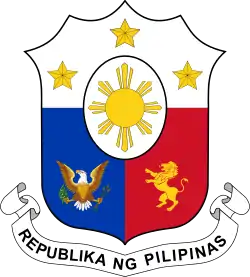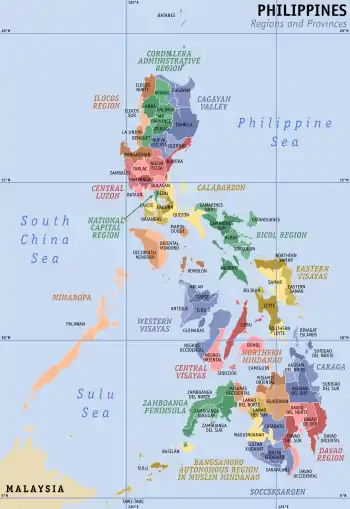Southern Tagalog
Southern Tagalog (Filipino: Timog Katagalugan), designated as Region IV, was an administrative region in the Philippines that comprised the current regions of Calabarzon and Mimaropa, the province of Aurora of Central Luzon (then part of Quezon Province until 1979), and several cities of Metro Manila.
| Southern Tagalog Timog Katagalugan | |||||||||
|---|---|---|---|---|---|---|---|---|---|
| Former region of the Philippines | |||||||||
| 1965–2002 | |||||||||
.svg.png.webp) Location within the Philippines | |||||||||
| Capital | Quezon City[1] (Regional Center) | ||||||||
| Population | |||||||||
• 2000[2] | 11,793,655 | ||||||||
| History | |||||||||
• Established | January 1, 1965 | ||||||||
• Disestablished | May 17, 2002 | ||||||||
| Political subdivisions | 11 provinces at the time of partitioning
| ||||||||
| |||||||||
| Today part of | |||||||||
It was partitioned into the two regions on May 17, 2002.[3]
History
Southern Tagalog was the largest region in the Philippines in terms of both land area and population. The 2000 Census of Population and Housing showed the region having a total of 11,793,655 people, which comprised 15.42 percent of the 76.5 million population of the country at that time.[2][4]
Quezon City was the designated regional center of Southern Tagalog.[1]
The former region covered the area where many reside; the two other majority-Tagalophone regions are the National Capital Region and Central Luzon.
Partitioning
Region IV or Southern Tagalog was divided into Calabarzon and Mimaropa, upon the issuance of Executive Order No. 103, dated May 17, 2002, by then-President Gloria Macapagal-Arroyo. Additionally, the province of Aurora was moved to Region III (Central Luzon).[3]
Administrative divisions
Provinces
| Province | Provincial capital | Current region |
|---|---|---|
| Aurora | Baler | Central Luzon |
| Batangas | Batangas City | Calabarzon |
| Cavite | Imus[lower-alpha 1] / Trece Martires[lower-alpha 2] | |
| Laguna | Santa Cruz | |
| Marinduque | Boac | Mimaropa |
| Occidental Mindoro | Mamburao | |
| Oriental Mindoro | Calapan | |
| Palawan | Puerto Princesa[lower-alpha 3] | |
| Quezon | Lucena[lower-alpha 3] | Calabarzon[lower-alpha 4] |
| Rizal | Cainta[lower-alpha 1][lower-alpha 5] / Antipolo[lower-alpha 2] | |
| Romblon | Romblon | Mimaropa |
Cities
Southern Tagalog region had 13 chartered cities prior to its partition.
Notes
- De facto capital
- De jure capital; Seat of government
- Highly urbanized city
- Several municipalities of Rizal were partitioned to form Metro Manila on November 7, 1975.
- Annexed into Metro Manila; highly urbanized city
References
- "Map of the Philippines". Philippine Country Guide. Archived from the original on July 17, 2006. Retrieved March 14, 2020.
- "Southern Tagalog: Biggest Region in the Philippines". Philippine Statistics Authority – Philippine Statistics Authority. Philippine Statistics Authority. January 2, 2003. Retrieved November 1, 2014.
- "Executive Order No. 103: Dividing Region IV into Region IV-A and Region IV-B, Transferring the Province of Aurora to Region III and for Other Purposes". Philippine Statistics Authority – National Statistical Coordination Board. Archived from the original on May 29, 2009. Retrieved November 1, 2014.
- World Geography Affected by World Upheavals. Goodwill Trading Co., Inc. p. 95. ISBN 9715740413.

